|
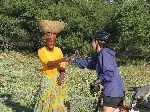
 We
determined that there was a rideable back road from Etsha 6 to Etsha 1, and true to form there was more life
along it than
there had been along the tar road. First we had a pleasant meeting
with a woman carrying a beautiful basket. Later we stopped and talked
to a group clearing bush from along the side of the road. It looked
like a lot of the focus of their activities was uprooting the small acacia
bushes. The crew described the work as drought prevention.
Usually clearing vegetation exacerbates dehydrating the soil. I can't connect
the objective as a logical consequence of the activity, unless the acacia is a
huge drain on the water table, which I have not heard of. (Eucalyptus
on the other hand is an example of a tree with a deep taproot, and a
thirst that can suck a water table dry.) We
determined that there was a rideable back road from Etsha 6 to Etsha 1, and true to form there was more life
along it than
there had been along the tar road. First we had a pleasant meeting
with a woman carrying a beautiful basket. Later we stopped and talked
to a group clearing bush from along the side of the road. It looked
like a lot of the focus of their activities was uprooting the small acacia
bushes. The crew described the work as drought prevention.
Usually clearing vegetation exacerbates dehydrating the soil. I can't connect
the objective as a logical consequence of the activity, unless the acacia is a
huge drain on the water table, which I have not heard of. (Eucalyptus
on the other hand is an example of a tree with a deep taproot, and a
thirst that can suck a water table dry.)
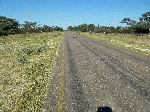
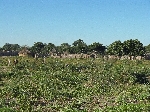
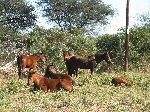
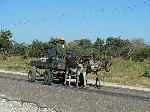
Through Namibia and up until Etsha in Botswana we hadn't see many horse or
donkey carts. Early there had only been a few ox drawn sleds, but this
was the extent of animal traction. In any case we had definitely seen a
greater number of horses and donkeys in the last few days.
Evidently there was a development project that introduced the carts into this area,
but we couldn't quite get a full story.
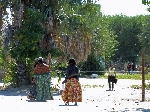 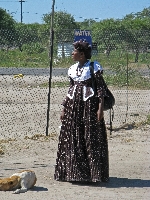 Someplace
south
of the Etshas, certainly in Gumare, we started to see Herero people.
Whereas the Biyeyi are the river people, who also farm and keep some cattle,
the Herero, at least historically, have been almost exclusively cattle
people. The Herero are probably most noted for their formal wear which
reflects nineteenth century German dress. The link being that
the Herero were originally
from the area that is now north central Namibia, which, up until the end of World War I, was a
German colony. In the last century and a half some of their
populations have moved east at various times to escape persecution, and to
find more land. The dresses take volumes of cloth (11 meters) that seem less than
practical in a region with scorching summer temperatures. We were also told that it takes a half-hour to fix their
head-tie alone. The language of the Herero is Otjiherero. A simple greeting
is "tjike" (hello). Someplace
south
of the Etshas, certainly in Gumare, we started to see Herero people.
Whereas the Biyeyi are the river people, who also farm and keep some cattle,
the Herero, at least historically, have been almost exclusively cattle
people. The Herero are probably most noted for their formal wear which
reflects nineteenth century German dress. The link being that
the Herero were originally
from the area that is now north central Namibia, which, up until the end of World War I, was a
German colony. In the last century and a half some of their
populations have moved east at various times to escape persecution, and to
find more land. The dresses take volumes of cloth (11 meters) that seem less than
practical in a region with scorching summer temperatures. We were also told that it takes a half-hour to fix their
head-tie alone. The language of the Herero is Otjiherero. A simple greeting
is "tjike" (hello).
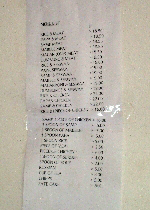 Gumare
had the first restaurants and substantial commercial center since Shakawe,
more than 100 kilometers up the road. The restaurants were run by
Chinese, Pakistanis, and locals. All the restaurants had essentially
the same menu. While Gumare seemed like a likely candidate for an Internet Café,
continuing our perfect record, there was none available. Gumare
had the first restaurants and substantial commercial center since Shakawe,
more than 100 kilometers up the road. The restaurants were run by
Chinese, Pakistanis, and locals. All the restaurants had essentially
the same menu. While Gumare seemed like a likely candidate for an Internet Café,
continuing our perfect record, there was none available.
 The communications masts along the road became a friendly beacon. With
few exceptions they signaled a settlement with at least a small store. In
several cases there were orange colored cell phone antennas at the top of the
tower and a sign with orange on black lettering welcoming you to the town,
and an orange square which is the Orange cell phone company's logo.
Was all of this orange just a coincidence? We were told that Orange offers
the best cell phone coverage in the area. My assumptions is that
Orange is responsible for raising the poles and nothing is coincidence -- it
is their marketing plan. Which reminds me: we had seen and talked to a
marketing team for "Be" mobile phones in Etsha. They were
handing out some swag and promoting their service as "newer and better".
"Be" uses the color kiwi green.
The communications masts along the road became a friendly beacon. With
few exceptions they signaled a settlement with at least a small store. In
several cases there were orange colored cell phone antennas at the top of the
tower and a sign with orange on black lettering welcoming you to the town,
and an orange square which is the Orange cell phone company's logo.
Was all of this orange just a coincidence? We were told that Orange offers
the best cell phone coverage in the area. My assumptions is that
Orange is responsible for raising the poles and nothing is coincidence -- it
is their marketing plan. Which reminds me: we had seen and talked to a
marketing team for "Be" mobile phones in Etsha. They were
handing out some swag and promoting their service as "newer and better".
"Be" uses the color kiwi green.
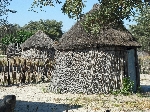
While most of the buildings in the area were made
of clay walls, we also saw the occasional building made with reed walls.
I have read that the !Kung would make houses from grasses, but this didn't
seem to be a !Kung area. There would be a lot of reeds available in
the delta, so it is plausible that the Biyeyi utilized it for some of their
other
construction needs. But this building, near Gumare, is quite a ways
from the water. The story behind this house will remain one of
hundreds of unanswered questions pondered during the trip. Any explanation
that I can offer is only speculation.
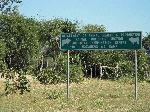 Within our
group there was some discussion of how sophisticated the animal husbandry
was in the Botswana cattle industry. In the herds along the
roadside there was evidence of systematic cross breading. Outside Nokaneng we came across a sign to the "Department of Animal Health
& Production, Animal Breeding Section, Artificial Insemination Center,
Nokaneng A. I. Camp." Checking the map, this is a huge installation.
There is probably more being done in the area of animal husbandry than meets
the eye. Within our
group there was some discussion of how sophisticated the animal husbandry
was in the Botswana cattle industry. In the herds along the
roadside there was evidence of systematic cross breading. Outside Nokaneng we came across a sign to the "Department of Animal Health
& Production, Animal Breeding Section, Artificial Insemination Center,
Nokaneng A. I. Camp." Checking the map, this is a huge installation.
There is probably more being done in the area of animal husbandry than meets
the eye.
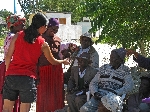 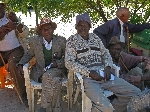 We
arrived in Nokaneng on what can be described as the monthly pensioner pay out day.
We had come across this before near Kongola, Namibia. It seems that
both the government of Namibia and the government of Botswana provide
monthly cash payments to their senior citizens. The We
arrived in Nokaneng on what can be described as the monthly pensioner pay out day.
We had come across this before near Kongola, Namibia. It seems that
both the government of Namibia and the government of Botswana provide
monthly cash payments to their senior citizens. The
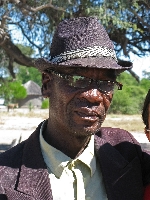 line seemed to
move slowly so line seemed to
move slowly so 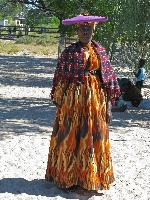 the
disbursement process seemed to involve considerable waiting for many.
Fortunately for us they were agreeable and eager to be photographed and enjoyed
seeing themselves on the displays of the digital cameras. Perhaps not
totally obvious, the local residents were from at least the Yeyi, Herero and
!Kung ethnic groups.
the
disbursement process seemed to involve considerable waiting for many.
Fortunately for us they were agreeable and eager to be photographed and enjoyed
seeing themselves on the displays of the digital cameras. Perhaps not
totally obvious, the local residents were from at least the Yeyi, Herero and
!Kung ethnic groups.
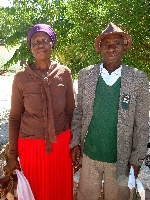
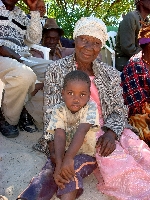
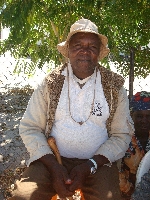
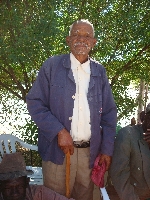
Strolling around town, of the many things that caught
my eye were: the construction of new classrooms at the school, the extensive
grid of power lines above the community, the dish antenna outside a
traditionally constructed clay and thatch building, and the general store /
bar / butcher shop / water tank.
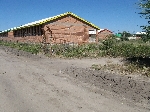
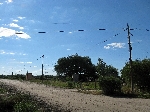

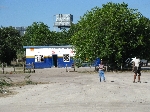
 It has been noticeable in Namibia and Botswana how much
of the housing still uses traditional construction materials
-- largely abandoned in other places for lower maintenance corrugated zinc
roofs.
It is probably not accidental because the construction with clay walls and
thatched roofs tends to be warmer in
the cold season, and cooler in the hot season. The same properties
would hold true
in other places where adaptive architecture has been abandoned in the
pursuit to be "modern". It has been noticeable in Namibia and Botswana how much
of the housing still uses traditional construction materials
-- largely abandoned in other places for lower maintenance corrugated zinc
roofs.
It is probably not accidental because the construction with clay walls and
thatched roofs tends to be warmer in
the cold season, and cooler in the hot season. The same properties
would hold true
in other places where adaptive architecture has been abandoned in the
pursuit to be "modern".
Similarly, for southern Africa, the Herero women are notable for
maintaining their pride in traditional dress.
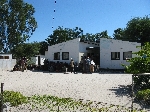
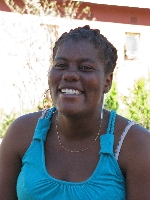 Our
accommodations for the night were arranged through the Khuta, or municipal
authority. We were told that we were the first travelers since 2002 to
stay in the community, and the previous group didn't come by bicycle.
The clerk at the Khuta also put us in touch with Odirereng, who agreed to
prepare dinner for us. It was a rather open ended arrangement. We
provided some upfront money for food, asked for a nice traditional meal,
asked her to tell us when it was ready and to let us know if she would bring
the meal to us or whether we should come to where she was to eat. Our
accommodations for the night were arranged through the Khuta, or municipal
authority. We were told that we were the first travelers since 2002 to
stay in the community, and the previous group didn't come by bicycle.
The clerk at the Khuta also put us in touch with Odirereng, who agreed to
prepare dinner for us. It was a rather open ended arrangement. We
provided some upfront money for food, asked for a nice traditional meal,
asked her to tell us when it was ready and to let us know if she would bring
the meal to us or whether we should come to where she was to eat.
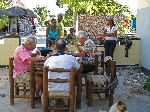 The call that the meal was ready came about 5pm, a bit
before we expected it and we were invited to come over to the house.
We were not disappointed. The dining table and chairs had been brought
outside on to a nice patio between two houses and the whole family (five
generations) was there to see us. From all that went on, they seemed
as excited to have the strangers as their guests as we were to be with a
family enjoying a wonderful meal. The menu was papa, chakalaka and
meat. The call that the meal was ready came about 5pm, a bit
before we expected it and we were invited to come over to the house.
We were not disappointed. The dining table and chairs had been brought
outside on to a nice patio between two houses and the whole family (five
generations) was there to see us. From all that went on, they seemed
as excited to have the strangers as their guests as we were to be with a
family enjoying a wonderful meal. The menu was papa, chakalaka and
meat.


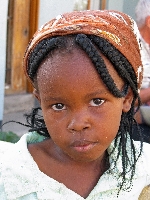
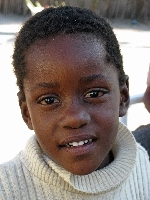
The congeniality didn't stop with the meal. One
of the guys in the group got invited out to the bar with a couple of the
women later in the evening.
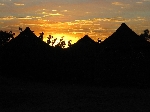 Our view of the sunset over Nokaneng. Goodnight.
Our view of the sunset over Nokaneng. Goodnight. |

































